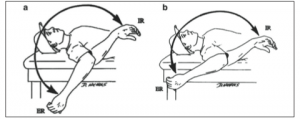Brian Schiff’s Blog
Injury Prevention, Sports Rehab & Performance Training Expert
I have a steady flow of baseball players who come to see me for shoulder and elbow rehab. As a former pitcher whose playing career was altered by an arm injury at age 14, I have a particular interest in throwing injuries. My son is a 6’2″ left-handed pitcher that plays showcase baseball. He will be the subject matter of this post moving forward.
Many of the players I see for shoulder and elbow pain suffer from pathological GIRD (glenohumeral internal rotation deficit). While it is common to see throwers with less internal rotation on their dominant side, it is important to assess total shoulder motion to make sure their mobility is within 5 degrees of their non-dominant side. Asymmetry in total shoulder motion and shoulder flexion increase the odds of elbow injuries. Click here to see the correlation in professional pitchers. Additionally, insufficient external rotation gain on the throwing arm increases injury risk. Click here to read an abstract summarizing data within the same group of professional pitchers.
Given this information and my background, I have preached arm care for years to my son. For some background, my son has pitched since he was 9 years old. Since I have been a coach for his team in one capacity or another since he was 10, I have closely monitored and controlled his pitch counts, innings per outing and total innings per year. He has always been able to throw hard, but he had a big growth spurt in middle school and his velocity grew with that.
He now throws between 75-77 mph as a HS freshman. He is projected to be 6’5″ tall and weighs 170 pounds at this time. His showcase coach pitched in MLB, and we have two other organizational pitching instructors with big league experience who supervise his weekly bullpens. His total innings pitched for 2017 = 43. Research indicates anything over 100 significantly increases injury risk. With all that said, he has developed some medial elbow pain over the past 4 months. He has no history of arm trouble to date. My intention is for this post to serve as useful diagnostic and proactive intervention for those who may see and experience similar cases.
I see plenty of pitchers in my clinic ranging from 12 y/o travel baseball players to MLB guys. My own son is a left handed pitcher so I am always carefully watching his mechanics, pitch count and arm care. There has been much written about glenohumeral internal rotation deficit (GIRD) and total shoulder motion over the years.

Today, I wanted to recap a nice article that was recently published in the American Journal of Sports Medicine by Wilk et al. looking at deficits in glenohumeral passive range of motion (PROM) and the increase in elbow injury risk.
This prospective study was done over an 8 year period from 2005-2102 and looked at PROM of both throwing and nonthrowing shoulders of all major and minor league pitchers within a single baseball organization. The measurements were taken with a bubble goniometer during spring training. See images below from the journal article for how measurements were taken:

In sum, 505 exams were performed on 296 pitchers. Motion was assessed in supine with the arm abducted to 90 degrees and the arm in the plane of the scapula. One examiner stabilized the scapula, while another measured total rotation and passive flexion. Elbow injuries and days missed because of injuries were assessed and recorded by medical staff. Throwing and nonthrowing measurements were compared, while additional testing was done to find significant associations between shoulder motion and elbow injury, as well as odds of an elbow injury.


